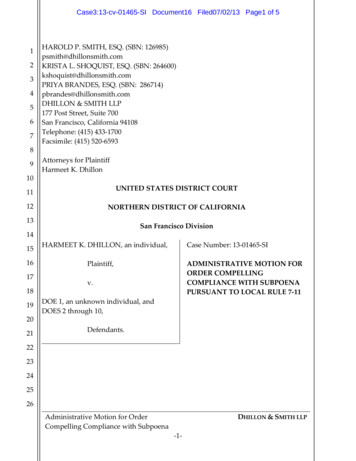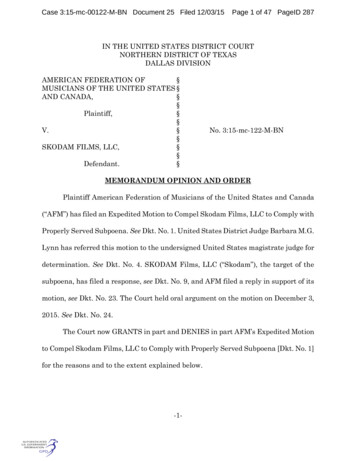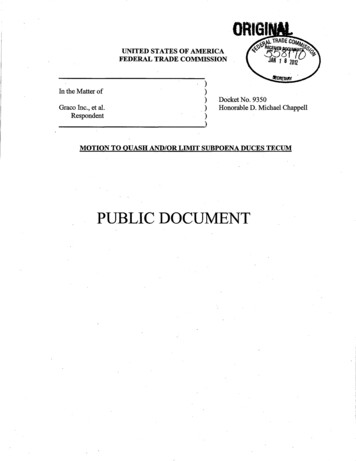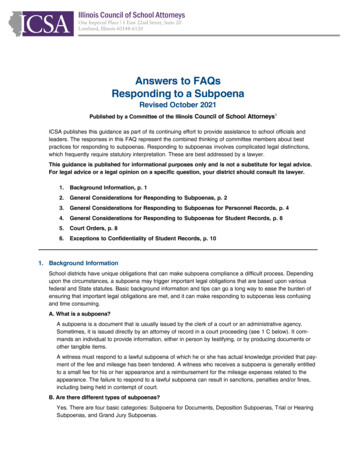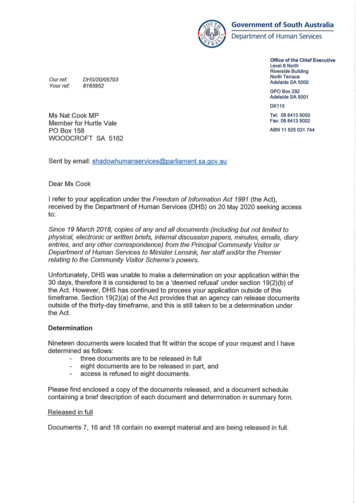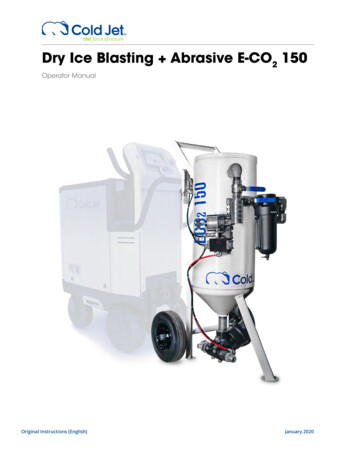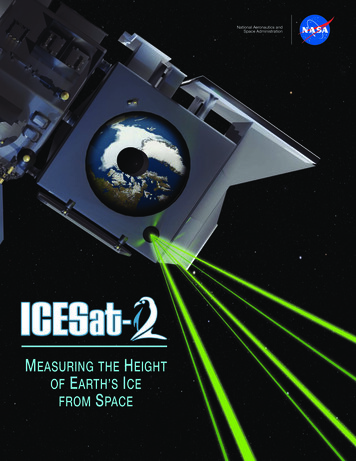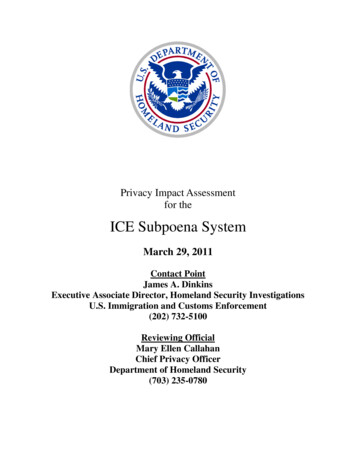
Transcription
Privacy Impact Assessmentfor theICE Subpoena SystemMarch 29, 2011Contact PointJames A. DinkinsExecutive Associate Director, Homeland Security InvestigationsU.S. Immigration and Customs Enforcement(202) 732-5100Reviewing OfficialMary Ellen CallahanChief Privacy OfficerDepartment of Homeland Security(703) 235-0780
Privacy Impact AssessmentU.S. Immigration and Customs Enforcement, ICE Subpoena SystemPage 2AbstractThe ICE Subpoena System (ISS) is owned and operated by the Office of Homeland SecurityInvestigations (HSI) within U.S. Immigration and Customs Enforcement (ICE), a component of theDepartment of Homeland Security (DHS). ISS automates the process of generating, logging, and trackingsubpoenas and summonses that ICE issues in furtherance of its investigations into violations of customsand immigration laws. It also supports the generation of Form I-9 notices, which notify employers thatICE intends to inspect their records to determine if they have completed the required employmenteligibility forms for their employees. ICE is conducting this PIA because ISS contains personallyidentifiable information (PII) about the individuals to whom these subpoenas, summonses, and notices aredirected as well as the individuals who are the subjects of these legal process documents.OverviewICE uses ISS to generate, log, and track administrative subpoenas, summonses, and notice ofForm I-9 inspection letters (Form I-9 notices) issued by the agency. ICE uses these documents to collectinformation during administrative and criminal investigations into violations of various immigration andcustoms laws, such as employment violations of U.S. immigration law, narcotics violations, financialcrimes, and human trafficking and smuggling. ICE policy requires each ICE field office to account for allsubpoenas and summonses issued within their areas of responsibility. ISS supports this requirement byallowing field offices to track the subpoenas, summonses, and Form I-9 notices they issue. ISS alsoallows ICE to track and report the issuance of these documents at an enterprise level. ISS replaces themanual logs previously maintained by individual offices to track this data. ISS also expedites andpartially automates the process by which ICE creates and issues subpoenas, summonses, and Form I-9notices.Subpoenas and SummonsesSubpoenas and summonses are judicially enforceable demands for records, information, ortestimony issued to a specific individual or entity by a government authority. ISS captures PII containedin a subpoena or summons issued by ICE, which consists of: (1) PII about the person to whom thesubpoena or summons is directed (if any) and (2) PII about a suspect or other individual involved in theinvestigation (e.g., witness, victim) whose records, information, or testimony are being demanded (ifany). When ICE serves a subpoena or summons on an entity like a corporation, the names of individualpoints-of-contact in a corporation (e.g., corporate legal counsel, a records custodian) may be included inthe subpoena or summons, if known, to help direct the document to the appropriate individual for action.Typically, ISS does not collect or store sensitive information about individuals; the individual’s name,title, and work contact information is usually all that is captured in the system. In cases where a subpoenaor summons is directed toward an individual and not an entity, ISS is likely to contain the individual’sname, home or work mailing address, and other contact information such as email address, home or worktelephone number, and/or a fax number.When the subpoena or summons is demanding testimony or seeking the production of records orinformation about an identified individual (typically the subject of an investigation or other personinvolved in the investigation), ISS may contain that individual’s name, address, Social Security number
Privacy Impact AssessmentU.S. Immigration and Customs Enforcement, ICE Subpoena SystemPage 3(SSN), date of birth, and or other data that is necessary to place on the subpoena or summons to allow theindividual receiving it to identify and collect the information or records being demanded by ICE. Thespecific information included in ISS and on the subpoena or summons will vary depending on whom thesubpoena or summons is being served and the nature of the information or records being sought. Forexample, a subpoena seeking financial records from a bank may disclose the subject’s name, SSN(because financial institutions often use the SSN to identify their account holders), and bank accountnumber, to allow the bank to identify the records demanded. A subpoena seeking information from astate department of motor vehicles may contain an individual’s driver’s license number, date of birth,SSN, and home address, for the same reason. To protect sensitive PII contained in the subpoena orsummons, ICE serves the document in person, by fax, or by mail. Documents are served by fax and sentto the contact information that is on file for the known fax numbers of the recipient. ICE does not servesubpoenas or summonses by electronic means. In cases where the subpoena or summons requests theproduction of documents, the instructions direct that any records returned electronically to ICE beencrypted if they contain sensitive PII.Form I-9 NoticesAll employers must complete and retain a Form I-9, Employment Eligibility Verification, foreach individual they hire for employment in the United States, regardless of the employee’s citizenship.1The Form I-9 instructions require that the employer examine the employment eligibility and identitydocument(s) of an employee to determine whether they reasonably appear to be genuine and relate to theindividual. The employer must also record the identity document information on the Form I-9 and retainit for three years after the hire date for the employee or one year after employment is terminated,whichever is later. ICE inspects employer records to determine if they have properly completed the FormI-9 for their employees and whether they are in compliance with employment requirements of theImmigration and Nationality Act. This is referred to as an Form I-9 audit. When ICE initiates an Form I9 audit, ICE generates an Form I-9 notice in ISS and sends it to the employer as advance notice of whenICE will arrive to review the employer’s I-9 forms. Form I-9 notices are always directed at employers,which are typically businesses but in some cases may be individuals. For Form I-9 notices directed to abusiness, ISS contains the name of the company official to whom the notice is addressed (typically theowner or chief executive), company name and address. When the Form I-9 notice is directed to anindividual employer, ISS contains that individual’s name and business or home address. Form I-9 noticesare served by mail or fax.ICE Subpoena SystemISS contains various tools that assist ICE agents, criminal research specialists, investigativeassistants, or other authorized users with generating subpoenas, summonses, and Form I-9 notices. ISStakes the information entered by a user into predefined fields and creates an electronic version of asubpoena, summons, or Form I-9 notice which is then sent via email to the user in PDF format for review,signature, and service on the recipient. ISS also stores the information used to complete the subpoenas,summonses, and Form I-9 notices in tables that allow for statistical reporting for an individual ICE officeor on an enterprise-wide basis.1The Form I-9 is issued by U.S. Citizenship and Immigration Services, DHS (OMB No. 1615-0047).
Privacy Impact AssessmentU.S. Immigration and Customs Enforcement, ICE Subpoena SystemPage 4ISS also contains two tools that support the issuance of subpoenas and summonses to telephoneservice providers (TSPs) when ICE is attempting to identify the owner of a particular telephone number.The first of these is the TSP Portability Tool, which allows ISS to use commercial data to identify in realtime the current TSP for any particular telephone number.2 During the creation of a subpoena orsummons, ICE personnel enter the telephone number into ISS and the TSP Portability Tool to query datafrom a commercial vendor to identify the appropriate TSP. ISS also notifies ISS users when an invalidnumber is entered into ISS. Invalid numbers are number combinations not used by TSPs. Invalidnumbers are written to an error log that is sent to the ISS user requesting the query. Once the proper TSPis identified, this information is automatically included in the subpoena or summons form being created inISS. Using the TSP Portability Tool increases the accuracy and efficiency of this process by reducing thenumber of misdirected subpoenas/summonses.Once the correct TSP for a telephone number is identified by the TSP Portability Tool, ISS usesthe second tool, the TSP Locator Tool, to determine the name and contact information for that TSP’ssubpoena compliance department.3 ISS then automatically inputs this information into the subpoena orsummons form. The TSP Locator Tool uses information from a commercial vendor that is stored locallyin the ISS database. ISS receives regular updates to this dataset from the vendor.Employees in other ICE offices, such as Enforcement and Removal Operations (ERO)deportation officers and immigration enforcement agents, may use ISS as well. These users are givenlimited privileges in ISS allowing them to use the TSP Portability and Locator Tools only. They areunable to generate or view subpoenas, summonses, or Form I-9 notices. These other users will access ISSto identify the current TSP for any particular telephone number and identify the name and contactinformation for that TSP’s subpoena compliance department.4ISS ProcessTo begin the process, an ICE agent engaged in a criminal investigation decides to issue asubpoena for business records from a company that is the target of the investigation. The agent assignsthis task to a criminal research specialist who logs into ISS, enters the ICE case number for theinvestigation, and selects the appropriate subpoena form. The specialist enters the company name,address, telephone number, and company official to whom the subpoena is directed, or in some cases thespecialist may be able to select the business from an existing list within ISS (if, for example, the businesshas been served with other subpoenas or summonses in the past). The specialist inputs a description ofthe specific records demanded by ICE through the subpoena. The specialist then selects from an existing2Telephone number portability allows subscribers to keep their existing telephone numbers when they changeservice from one telephone service provider to another, regardless whether the service is wireline, wireless, voiceover IP (VoIP) or cable. The TSP Portability Tool allows ICE to determine the current TSP for the telephonenumber of interest, regardless of if and when the number was ported.3ICE may also use the TSP Locator Tool to identify the TSP for an owner of a particular telephone number but asthe information for the TSP Locator Tool is only updated on a monthly basis in almost all cases the TSP PortabilityTool is used to access the real time TSP for any owner of a particular telephone number.4ERO will use this information to generate and serve subpoenas or summonses on TSPs to obtain informationregarding the owner of a particular telephone number, such as the owner’s address, to facilitate ERO’s service ofcourt orders, grand jury subpoenas, or other documents related to administrative immigration matters. At this time,ERO does not use ISS to generate or track subpoenas or summonses that it issues.
Privacy Impact AssessmentU.S. Immigration and Customs Enforcement, ICE Subpoena SystemPage 5list the name of the ICE agent and the name of the authorizing ICE official who will sign the subpoena. 5ISS assigns a unique tracking number to the subpoena and emails the unsigned subpoena electronically inPDF format to the specialist, who prints the document and delivers it to the agent. After reviewing thesubpoena to ensure it is correct, the agent presents it to the authorizing ICE official for signature. 6 Onceapproved and signed, the subpoena is served on the company by the ICE agent. Finally, when the recordsdemanded in the subpoena are provided to ICE, the date of that record production, known as the “returndate,” is entered into ISS by the specialist or agent.Section 1.0 Authorities and Other Requirements1.1What specific legal authorities and/or agreements permitand define the collection of information by the project inquestion?ICE’s legal authority for the issuance of subpoenas, summonses, and Form I-9 notices are 50U.S.C. App. § 2411(a) for the Export Subpoena; 21 U.S.C. § 967 for the Controlled SubstanceEnforcement Subpoena; 19 U.S.C. § 1509 for the Customs Summons; Immigration and Nationality Act(INA) § 235(d)(4)(A) for the Immigration Subpoena; and INA § 274A(e)(2)(C) for the Form I-9 notice.1.2What Privacy Act System of Records Notice(s) (SORN(s))apply to the information?The applicable SORN is the DHS/ICE-009 External Investigations SORN (January 5, 2010, 75FR 404).1.3Has a system security plan been completed for theinformation system(s) supporting the project?The Certification & Accreditation process is currently in progress and expected to be completedin October 2011.1.4Does a records retention schedule approved by theNational Archives and Records Administration (NARA)exist?No. ICE is developing a proposed retention schedule consistent with the retention periodsdescribed below for submission to NARA.5The process for the I-9 notice is similar. The I-9 notice is a form letter completed by the ISS user by providing thename of an individual and the company name to be served the I-9 notice. The ISS user then selects the inspectiondate, case agent name and the signer name.6At ICE, the authorizing official for a subpoena is the Assistant Special Agent in Charge or above, and for asummons the Special Agent in Charge or designee. For I-9 notices, the issuing authority is a Group Supervisor orabove.
Privacy Impact AssessmentU.S. Immigration and Customs Enforcement, ICE Subpoena SystemPage 61.5If the information is covered by the Paperwork ReductionAct (PRA), provide the OMB Control number and theagency number for the collection. If there are multipleforms, include a list in an appendix.The information collected during the process described in this PIA is not covered by thePaperwork Reduction Act.Section 2.0 Characterization of the InformationThe following questions are intended to define the scope of the information requested and/or collected, aswell as reasons for its collection.2.1Identify the information the project collects, uses,disseminates, or maintains.ISS retains the following categories of records containing PII:(1) ICE Employee and Case Data: ISS maintains the name, badge number, business address,telephone number and email address for the ICE agent and criminal research specialist who created thesubpoena, summons, or Form I-9 notice, the authorizing ICE official who signs the subpoena, summons,or Form I-9 notice, and the ICE official who will receive the records or information demanded in thesubpoena/summons. In most cases, the ICE agent will be designated to receive the documents demandedin the subpoena/summons. ISS also maintains the name of the proceedings, if any, and the ICE casenumber of the investigation for which the subpoena, summons, or Form I-9 notice is being issued.(2) Recipient Data: For subpoenas and summonses, ISS maintains the name, mailing address,telephone number, fax number, and/or email address of the person or entity to which thesubpoena/summons is directed (i.e., the recipient). When directed to an entity such as a corporation, ISStypically will also retain the name of the individual in the subpoena/legal compliance department towhom the subpoena or summons is specifically addressed and their contact information. For Form I-9notices, ISS retains the name of the company official, company name, and address.(3) Target Data: For subpoenas and summonses that seek records or information about anidentified individual, ISS maintains PII about the target, i.e., the person whose information, records, ortestimony are demanded from the recipient of the subpoena or summons.7 This information varies incontent, but could include PII such as name, addresses, SSN, Tax Information Number, importernumbers, exporter numbers, Alien Registration Number, date of birth, email address, Internet protocol(IP) addresses, uniform resource locators (URLs), bank account numbers, telephone numbers, otherpersonal identification numbers,8 device identifiers and serial numbers, and other information that could7Not all subpoenas and summonses demand information about an individual.Personal identification numbers are account numbers or other unique identifiers associated with financial accounts,communication devices, telephone calling cards, and other similar items. ICE administrative and criminalinvestigations into violations of various immigration and customs laws, such as employment violations of U.S.immigration law, narcotics violations, financial crimes, and human trafficking and smuggling may require the8
Privacy Impact AssessmentU.S. Immigration and Customs Enforcement, ICE Subpoena SystemPage 7be linked to individuals whose information is demanded. ISS stores this information in tables and usesthe information to fill in the narrative field of the subpoena or summons form. Form I-9 notices do notcollect or use this type of information.(4) TSP Portability Data: Real time commercial data provided by a vendor that containsinformation about the current TSP for a particular telephone number. TSP Portability Data is a separatedatabase maintained by the vendor that is queried by ISS. The information ISS receives in response to aquery of a particular telephone number is limited to the name of the current TSP.(5) TSP Locator Data: Commercial data provided by a vendor, downloaded to ISS on a monthlybasis, that contains the name and contact information for the subpoena compliance departments forrelevant TSPs. This information is updated on a monthly basis by a vendor and is retained locally in theISS database.2.2What are the sources of the information and how is theinformation collected for the project?The ICE Employee Data is manually input by the ICE employees themselves or by theircolleagues. The Recipient Data and Target Data are typically derived from ICE criminal andadministrative investigations and may be retrieved from ICE investigative case files and other ICE lawenforcement recordkeeping systems. This information is derived from various investigative sources, suchas telephone records requested at an earlier date; witness interviews; confidential informant debriefings;other government agencies; evidentiary documents obtained by subpoena, inspection, search warrant, orauthorized electronic surveillance; and public records. This information is input manually into the systemby an ISS user. If a TSP is the recipient of a subpoena or summons, the Recipient Data may also beobtained in whole or in part from the TSP Locator Data and the TSP Portability Data.The TSP Locator and TSP Portability Data are obtained from a commercial vendor. The TSPLocator Data is stored in the ISS database and is updated electronically on a monthly basis by the vendor.This update is completed manually when an ICE employee downloads the most recent update from thecommercial vendor’s website. ISS accesses but does not download the TSP Portability Data when itsends a telephone number query over the Internet via a Secure Socket Layer (SSL) connection to thevendor’s database.2.3Does the project use information from commercial sourcesor publicly available data? If so, explain why and how thisinformation is used.Yes. As described above, the TSP Locator and TSP Portability Data are obtained from acommercial vendor. TSP Portability Data is used by ICE to identify the TSP for a particular telephonenumber when ICE is seeking to identify the owner of that number. TSP Locator Data is used to determinethe name and contact information for the subpoena compliance departments for TSPs so that a subpoenaor summons can be served on the TSP.collection of personal identification numbers for investigative purposes.
Privacy Impact AssessmentU.S. Immigration and Customs Enforcement, ICE Subpoena SystemPage 82.4Discuss how accuracy of the data is ensured.The accuracy of information used in ICE subpoenas, summonses, and Form I-9 notices must beverified by the user, agent, criminal research specialist or any other ISS user. Subpoenas, summonses,and Form I-9 notices containing incorrect information can be voided and reissued by ICE. Although ICEagents are the requestors of this information, ICE criminal research specialists, investigative assistants,and contract employees often perform the ISS query and subpoena generation activities at the request ofthe ICE agent. These duties include manual entry of Recipient and Target Data as well as entering adescription of the records or information ICE is demanding, in the case of a subpoena or summons. Theyalso identify the preferred method(s) for responding to a subpoena or summons.For a subpoena or summons seeking the identity of a telephone number owner, ISS uses the TSPPortability Tool to identify the TSP that is currently servicing the telephone number of the subject of thesubpoena or summons. ISS uses commercial data obtained from a vendor and found in the ISS LocatorTool to identify the subpoena compliance department contact information for the TSP that is servicingthat telephone number. ISS also notifies ISS users when an invalid number is entered into ISS. Invalidnumbers are number combinations not used by TSPs. These invalid numbers are written to an error logthat is sent to the ISS user that requested the query.If the vendors provide ICE with inaccurate data concerning the TSPs, ICE will discover suchinaccuracies when the TSPs on whom the subpoenas or summonses are served respond to the demands forinformation. If ICE obtained and acted on inaccurate information from the commercial data sources, itcould serve the wrong TSP with a subpoena for records seeking the identity of the owner of a particulartelephone number, which would result in ICE not obtaining the information it seeks in a timely manner.This would cause ICE to reissue the subpoena to the correct TSP, but it would not result in theproliferation of incorrect PII or in prejudice to any individual. If through experience, ICE finds that theinformation provided by the vendor contains an unacceptable number of errors, ICE will have recourse toaddress these data quality issues with the vendor through remedies provided for in the contract, or toterminate the contract and seek an alternative source of information.2.5Privacy Impact Analysis: Related to Characterization of theInformationPrivacy Risk: ISS could present a risk of the over-collection of PII.Mitigation: ICE only collects the information necessary to generate, log, track, and maintaincopies of administrative subpoenas, summonses, and Form I-9 notices issued by the agency. All PIIentered and collected is necessary for the purpose of generating, logging, tracking, and maintaining thesedocuments properly. The information returned to ICE in response to a subpoena or summons, orcollected during an Form I-9 audit, is not entered into ISS because maintenance of that data in the ISSsystem would be inconsistent with its limited purpose of tracking and generating the subpoenas,summonses, and Form I-9 notices.Privacy Risk: The use of commercial data could present a risk of data inaccuracy.
Privacy Impact AssessmentU.S. Immigration and Customs Enforcement, ICE Subpoena SystemPage 9Mitigation: ICE promotes data accuracy and integrity when using commercial sources by usingcredible commercial sources to increase the probability of identifying valid, relevant information aboutindividuals. If such sources provide ICE with inaccurate data concerning the TSPs, ICE will discoversuch inaccuracies when the TSPs on whom the subpoenas or summonses are served respond to thedemands for information. If ICE obtained and acted on inaccurate information from the commercial datasources, it could serve the wrong TSP with a subpoena for records pertaining to the owner of a particulartelephone number, which would result in ICE not obtaining the information it seeks in a timely manner.This would cause ICE to reissue the subpoena to the correct TSP, but it would not prejudice anyindividual. If through experience ICE finds that the information provided by the vendor contains anunacceptable number of errors, ICE will have recourse to address these data quality issues with thevendor through remedies provided for in the contract, or to terminate the contract and seek an alternativesource of information.Section 3.0 Uses of the InformationThe following questions require a clear description of the project’s use of information.3.1Describe how and why the project uses the information.As noted in Section 1.0, ICE has statutory authority to issue administrative subpoenas,summonses, and Form I-9 notices for the enforcement of immigration and customs laws. The primaryfunction of the ISS is to generate, log, and track administrative subpoenas and summonses duringcriminal and administrative investigations, and Form I-9 notices issued by the agency duringadministrative investigations. Administrative subpoenas and summonses are issued to compel testimonyor the production of documents or information, in aid of conducting an investigation into the possibleviolations of law including immigration and customs laws. Form I-9 notices are issued to provideadvance notice to an employer that ICE has scheduled an inspection of the employer’s I-9 Forms.ISS also allows each ICE Special Agent in Charge to account for all subpoenas and summonsesissued within their respective area of responsibility (i.e., HSI field office), as is required by ICE policy.In addition to accounting for all subpoenas and summonses issued, ISS also accounts for all Form I-9notices issued. Thus, ISS replaces the separate logs formerly maintained by individual offices and tracksthe information on an enterprise level.ISS takes the information that is entered by a user into predefined fields and creates an electronicversion of a subpoena, summons, or Form I-9 notice which is then sent via email to the user in PDFformat for review, signature, and service on the recipient. Target and Recipient Data is entered and usedto actually issue the subpoena/summons or Form I-9 notice so that it is received by the intended recipientand, in the case of summonses and subpoenas, to ensure the relevant information/records are returned toICE in response. The TSP Locator Data and the TSP Portability Data are both used by ICE and the ISSsystem to identify the appropriate TSP that should be the recipient of a subpoena or summons seeking toidentify the owner of a particular telephone number, and to verify that the telephone number is valid.ISS also provides certain ICE employees, who do not work in HSI, with Basic User accounts.These Basic Users will include ERO deportation officers and immigration enforcement agents who will
Privacy Impact AssessmentU.S. Immigration and Customs Enforcement, ICE Subpoena SystemPage 10use ISS to identify the current TSP for any particular telephone number and identify the name and contactinformation for that TSP’s subpoena compliance department. ERO will use this information to generateand serve subpoenas or summonses on TSPs to obtain information regarding the owner of a particulartelephone number, such as the owner’s address, to facilitate ERO’s service of court orders, grand jurysubpoenas, or other documents related to administrative immigration matters, such as a notice to appear.However, Basic Users will not have the ability to generate or view subpoenas, summonses, or Form I-9notices and may only use ISS to identify the current TSP for a particular telephone number and todetermine the name and contact information for the subpoena compliance department at a particular TSP.There are several tools within ISS that are used to process and/or analyze data. These toolsenhance the ability of ISS users to organize and track the status of subpoenas, summonses, or Form I-9notices they generated. The logs and reports generated by ISS are designed to be used by the ICE agent,the criminal research specialist and the investigative assistant to manage document generation, identifyduplication, and to enhance the ongoing investigation.(1) Batch Processing of Telephone Numbers: Data files containing lists of telephone numberscan be imported into the application. ISS correlates the numbers to the correct service provider using theTSP Locator Tool and the TSP Portability Tool and then generates the subpoena/summons documents forrecords pertaining to those telephone numbers.(2) Duplicate Requests: ISS automatically blocks telephone numbers from appearing on multiplesubpoenas/summons for the same ICE case number. This prevents ICE from making duplicate requestsfor the same information in the same investigation. All blocked information is written to a log file that isemailed to the person who entered the information into the ISS.(3) Subpoena Logs: ISS generates logs of subpoenas and/or summonses issued by a particularICE office. Logs can be generated by telephone number, case number, range of subpoena numbers, anddate.(4) Reports: ISS can produce a number of reports such as the subpoena log; telephone crossreference report; case number report; and outstanding subpoena report. The outstanding subpoena reportcaptures the subpoenas/summonses that have been served where a response from the rec
information for that TSP's subpoena compliance department.4 ISS Process To begin the process, an ICE agent engaged in a criminal investigation decides to issue a subpoena for business records from a company that is the target of the investigation. The agent assigns this task to a criminal research specialist who logs into ISS, enters the ICE .
